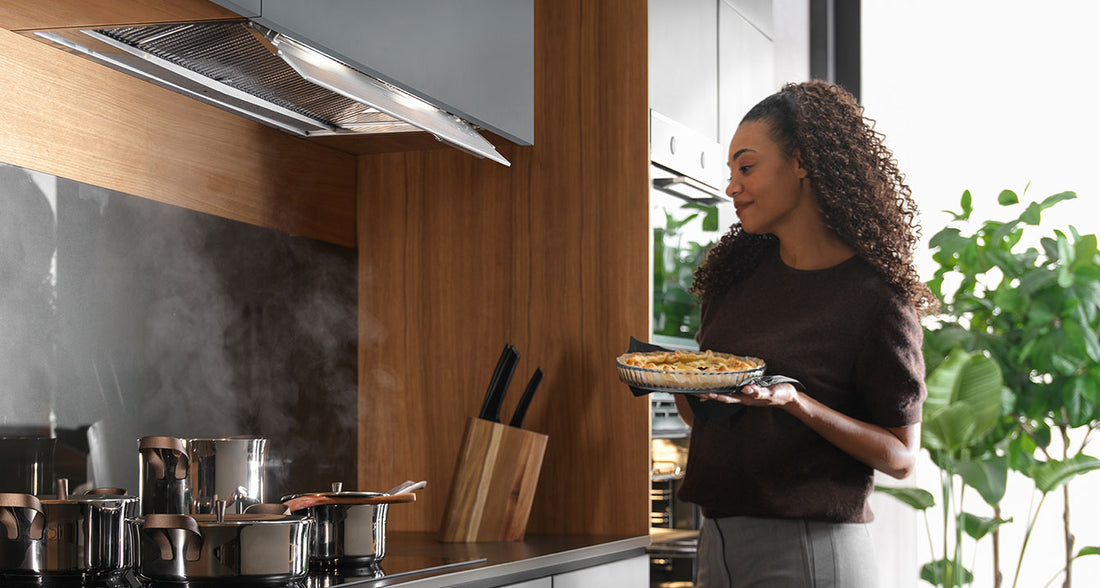In any home, the kitchen is undeniably the room most at risk of indoor pollution, where the air quality is most likely to suffer due to the smoke, odours and organic particles produced during food preparation.
When cooking vapours come into contact with colder surfaces, in addition to the problem of harmful odours, there is also the problem of condensation forming on the extractor hood, especially if you use an induction hob. Although this type of hob has the advantage of less pollutants being released into the air, they also have the disadvantage of producing more condensation than gas hobs due to their higher heating efficiency and speed. This unpleasant phenomenon can lead to the deposit of dirt and, over time, also to wear on surfaces.
The good news is that by paying a little more attention to your cooking space, the condensation problem can be solved effectively.
In this article, we will explain why condensation forms on the hood, together with valid advice on how to continue using it correctly. Without risking its malfunction or compromising the hygiene of your kitchen.
CAUSES OF CONDENSATION IN EXTRACTOR HOODS
The formation of condensation on your extractor hood is simply the result of a thermal shock between the cold temperature of the hood surface and hot steam and humidity rising from the hob during food preparation. This phenomenon is even more noticeable during winter as the metallic surfaces are made colder by the ambient temperature. This can result in condensation droplets forming on the hood surface, which tend to mix with grease residue and accumulate inside the hood. The resulting layer of dirt risks both clogging the grease filters in the hood and attracting airborne contaminants (such as dust). Not to mention that drops of moisture can fall on the hob, undermining kitchen hygiene and cooking safety and also risk damaging furniture/cabinets.
PRACTICAL REMEDIES FOR CONDENSATION IN THE HOOD
How can condensation be avoided in the case of induction hobs?
Here are some practical tips to try to solve, or at least curb, this annoying situation:
- Always use the hood – Contrary to what instinct suggests, not using the hood often is one of the main causes of condensation.
- Turn on the hood before cooking – To maximize the effectiveness of the hood, turn it on before cooking: this will prepare it to manage the steam effectively and prevent condensation.
-
Cover your pans with lids – To limit the escape of steam and reduce thermal shock between the hood and the steam, always try to cover pots and pans.
- Keep your hood well-maintained – Checking the hood filters is another anti-condensation remedy: while you can wash the metal grease filters (or replace them if they are particularly dirty), the activated carbon filters in the filtering hoods must be replaced periodically to ensure adequate air purification.
- Install an Anti-Condensation Hood – Does the phenomenon persist despite all these precautions? A really effective solution can be to install an anti-condensation hood that can completely eliminate the problem of condensation in the kitchen.
IN NOVA ZERO DRIP BY FABER: THE ULTIMATE SOLUTION TO THE CONDENSATION PROBLEM
A pioneer of innovation in the kitchen universe, Faber addresses the problem through its series of hoods IN NOVA ZERO DRIP, which all have the Zero Drip technology. These built-in hoods effectively combat condensation the moment it forms: by collecting it in a special tray, while, in the Plus version, the condensation is evaporated through thermal resistance.
A triumph of advanced technology and intelligent design, this range offers a variety of models, each with its own distinct features to ensure superior performance and keep the kitchen dry at all times.
Designed to offer maximum suction power and active protection against condensation, IN-NOVA Zero Drip effectively captures cooking vapours and fumes thanks to the large suction surface and the excellent airflow. The Zero Drip technology ensures the protection of kitchen furniture through a grease filter that is specially inclined so that the drops of condensation collect in a special tray that can be easily emptied with one hand. A filter saturation alarm warns you when it is time to clean or replace the filters. Available in different colours and sizes – also available with K-Link technology for those measuring 60 cm and 90 cm – the hood can be adapted to various types of kitchens. A pinnacle of innovation, the IN-NOVA Zero Drip Plus model is also equipped with a thermal resistance along the entire length of the glass, thus offering a double protection against condensation.
Another Faber range of hoods that has the Zero Drip technology is the Glam range of vertical hoods, characterised by a minimalist design and clean, essential lines. A distinguishing feature of the protagonist model of the range, Glam-Light Zero Drip Plus wall-mounted extractor hood is its elegant panel: a simple touch of the "Zero Drip" button activates the thermal resistance located on the glass and inside the hood, thus actively preventing the formation of condensation droplets, even during prolonged cooking. The special matt surface and shiny details make it a fully contemporary glam model.
Condensation on the cooker hood is a common and annoying, but avoidable problem. By using the hood regularly, switching it on before cooking and ensuring good maintenance, it is possible to reduce the risks and unpleasant consequences of this phenomenon. To solve this problem once and for all, the installation of an anti-condensation hood offers a complete and advanced solution, ensuring a dry and protected kitchen at all times, where you can cook, eat and entertain with the serenity you deserve.









